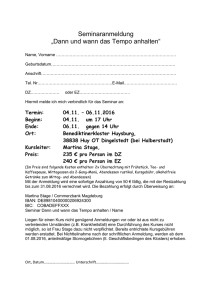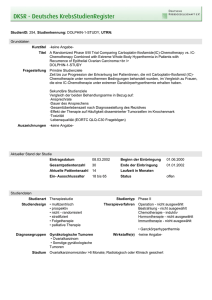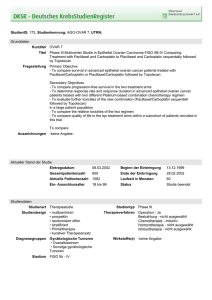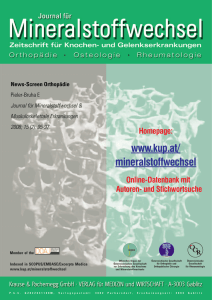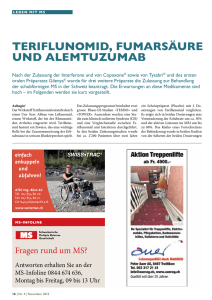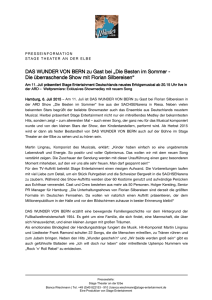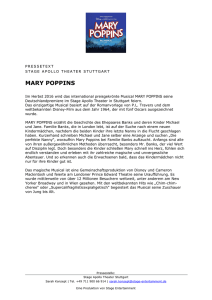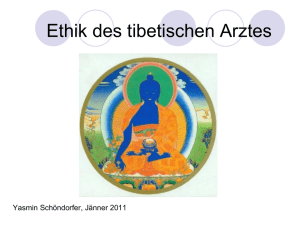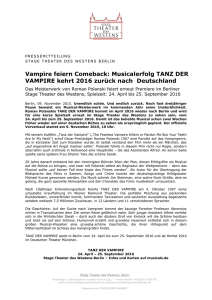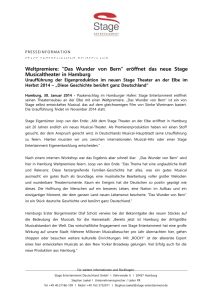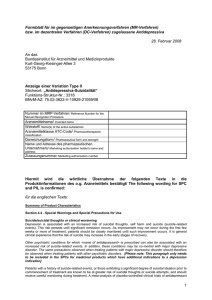Infektionsmanagement bei immunsupprimierten Patienten
Werbung
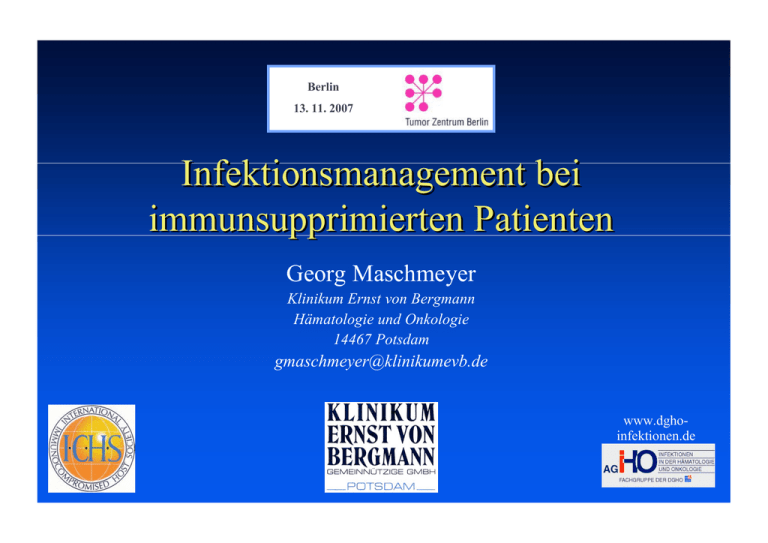
Berlin 13. 11. 2007 Infektionsmanagement bei immunsupprimierten Patienten Georg Maschmeyer Klinikum Ernst von Bergmann Hämatologie und Onkologie 14467 Potsdam [email protected] www.dghoinfektionen.de Infektionen bei febrilen neutropenischen Patienten Neutrophile < 1000/µl Fieber ≥ 38.5°C n = 1573 FUO n = 800 51% Bakteriämie oder Fungämie n = 222 14% Andere Lungeninfiltrate dokumentierte n = 269 Infektion 17% n = 262 17% Link H et al, Ann Hematol 1994;69:231-43 Bakteriämie: Trend zu Gram-positiven Erregern Viscoli C & Castagnola E, in: Mandell GL et al, Principles and Practice of Infectious Diseases, 6th ed., p. 3442-62 Indikation zur empirischen antimikrobiellen Intervention bei Tumorpatienten • Granulozyten < 500/µl oder < 1000/µl mit erwartetem Abfall auf ≤ 500/µl • Einmalige orale Temperatur > 38.3°C *) – Oder 2x ≥ 38.0°C innerhalb 12 h – oder ≥ 38.0°C über ≥ 1 h • Keine offensichtlich nicht-infektiöse Ursache – z. B Reaktion auf Blutprodukte oder Medikamente • Therapieeinleitung innerhalb max. 2 Stunden! *) Cave antipyretischer Effekt von Steroiden, NSAID, Paracetamol, Novaminsulfon Diagnostik vor Therapiebeginn • Körperliche Untersuchung, vor allem - Haut und Schleimhäute - Venöse Zugänge, Punktionsstellen - Atemwege - Urogenitalsystem - Abdomen, Perianalregion • Rö.-Thoraxorgane in zwei Ebenen • Mikrobiologische Initialdiagnostik 2 Paare (aerob/anaerob) Blutkulturen aus peripherer Vene, bei liegendem ZVK eines aus ZVK • Weitere Mikrobiologie nur bei entsprechender Infektionssymptomatik • Klinisch-chemische Diagnostik Diff-BB, TA, LDH, AP, GGT, Bili, Krea, Quick, aPTT, CRP; bei Hinweis auf Sepsis Lactat Infektionserreger mit charakteristischen klinischen Befunden Klinische Befunde Typische Erreger Rötung/Schmerz am Venenkatheter Koagulase-negative Staphylokokken Schleimhautulzera Alpha-hämolysierende Streptokokken, Candida spp., Herpes simplex-Viren Flohstichartige Hautrötungen Gram-positive Kokken, Candida spp. Nekrotisierende Hautläsionen Pseudomonas aeruginosa, Aspergillus spp. Retinainfiltrate Candida spp. Diarrhoe, Meteorismus Clostridium difficile Enterocolitis, perianale Läsionen Polymikrobiell incl. Anaerobier Lungeninfiltrate ± Sinusitis Aspergillus spp., Zygomyzeten, P. jiroveci => Eine gründliche klinische Untersuchung ist unverzichtbar! Piperacillin/Tazobactam vs Cefepime as Initial Empirical Therapy of Febrile Neutropenic Patients with Hematologic Malignancy Bow EJ et al (multicenter), Clin Infect Dis 2006;43:447-5 Indikationen zur primären Modifikation der antimikrobiellen Therapie: „Präemptive“ bzw. „kalkulierte“ Therapie • Lungeninfiltrate – CT/Röntgenbild typisch für Pneumocystis-Pneumonie – CT typisch für oder vereinbar mit invasiver Aspergillose • Venenkatheter-assoziierte Infektionen • Abdominelle oder perianale Infektionen PEG Studien I und II Patienten mit Fieber und Lungeninfiltraten profitieren von der unverzüglichen Gabe von Amphotericin B n CR (%) NR (%) ED (%) 157 78.2* 4.2 17.6 • Supplementierung von AmB + 5-FC nur bei Non-Respondern 269 61.3* 17.1 21.6 • Antibiotika plus AmB ± 5-FC ab Tag 1 • AmB vs AmB + 5-FC: kein signifikanter Unterschied *) p < 0.01 (Fisher's exact test, zweiseitig) Patienten mit ZVK-Infektionen: Ansprechen auf empirische Standardantibiotika + Vancomycin n CR NR ED Nur klinisch dokumentiert 113 88% 8% 4% Klinisch + mikrobiologisch dokumentiert 26 85% 8% 8% Gesamt 139 87% 8% 5% Link H et al (PEG-Studie I), Ann Hematol 1994;69:231-43 Septikämien bei akuter Leukämie: Port vs ZVK Johansson E et al (Stockholm), Support Care Cancer 2004; 12:99–105 Klinisch manifeste ZVK-bedingte Thrombosen bei 105 Tumorpatienten * *) ≥2 positive konsekutive Kulturen aus ZVK-“lock fluid“ Van Rooden CJ et al (Leiden, NL), J Clin Oncol 2005;23:2655-60 ZVK-bedingte Infektionen bei Tumorpatienten: Minocyclin/Rifampicin-Beschichtung n = 182 n = 174 Hanna H et al (MDACC), J Clin Oncol 2004;22:3163-71 Indikationen zur Entfernung des Katheters bei Venenkatheter-assoziierter Infektion (nach Fätkenheuer et al, AGIHO) • Primäre Katheterentfernung • Bakteriämie durch Staphylococcus aureus • Bakteriämie durch Bacillus spp. • Candidämie durch infizierten Katheter • Tunnel- oder Tascheninfektion • Septische Thrombose/Embolie • Lokale Abszedierung • Sekundäre Katheterentfernung (nach primärer antimikrobieller Therapie unter Belassung des Katheters) – Persistierend positive Blutkulturen nach 3 Tagen adäquater antibiotischer Therapie – Wiederauftreten von Fieber unmittelbar nach Absetzen der antimikrobiellen Therapie www.dgho-infektionen.de Modifikation der Therapie bei Patienten mit abdominellen oder perianalen Infektionen • Immer polymikrobielle Ätiologie bedenken! – Gram-negative Enterobacteriaceen + P. aeruginosa – Enterokokken – Anaerobier Glenn J et al, Rev Infect Dis 1998;10:42-52; Rolston KV & Bodey GP, Curr Clin Top Infect Dis 1993;13:164-71 • Bei Enterocolitis: Clostridium difficile-Toxin – Positive Kultur allein ist nicht ausreichend! Shim JK et al, Lancet 1998;351:633-6 Entscheidender Faktor: Erholung der Neutrophilen - PEG Studie I (n = 1573) Anstieg Kein Anstieg p FUO - Ansprechen - Tod 97.8% 86.5% < 0.001 1.5% 8.5% < 0.001 86.9% 62.3% < 0.001 7.0% 20.5% < 0.001 Dokumentierte Infektion - Ansprechen - Tod Link H et al, Ann Hematol 1994;69:231-43 Risikoadaptierte empirische Therapie: AGIHO www.dgho-infektionen.de Cipro/AmoxiClav oral vs Ceftriaxon/Amikacin i.v. bei febrilen Patienten mit Neutropeniedauer < 10 Tagen - EORTC-IATCG Studie XIII - • n = 177 vs 176 • Neutropeniedauer nach Fieberbeginn • Behandlungserfolg (ITT) - bei Pat. mit Neutropenie >7 Tage - bei Pat. mit Bakteriämie • Überleben Tag 7 – Überleben Tag 30 • Nebenwirkungen – medikamentenbedingt 4 (1-18) Tage 80 vs 77% 47 vs 50% 54 vs 50% 98 vs 97% 95 vs 95% 36 vs 31% 16 vs 15% Kern WV et al, N Engl J Med 1999;341:312-8 Cipro + AmoxiClav oral vs Ceftazidim i.v. bei febrilen Tumorpatienten mit Neutropenie < 10 Tagen • n = 116, doppelblind, Kinder eingeschlossen • Mediane Neutropeniedauer 3.4 vs 3.8 Tage • Erfolg (ITT) bei FUO 71 vs 67% - bei Pat. mit gesicherter Infektion • Unverträglichkeit 41 vs 33% 29 vs 7% Freifeld A et al (NCI multicenter), N Engl J Med 1999;341:305-11 Orale antimikrobielle Prophylaxe: Levofloxacin - - Moxifloxacin von Baum H et al (Ulm/Germany), J Antimicrob Chemother 2006,58:891-4 MASCC Score > 21 = Low-Risk Klastersky J et al (MASCC), J Clin Oncol 2000;18:3038-51 Febrile hämatologische Niedrigrisikopatienten: Entlassung mit oraler Antibiotikatherapie • • • • • • 279 Episoden febriler Neutropenie, 38% MASCC low risk 36% ungeeignet für orale antimikrobielle Therapie 64% bekamen orale Antibiotika nach Entlassung 95% der entlassenen Patienten blieben stabil fieberfrei 3 notfallmäßige Wiederaufnahmen Sterblichkeit 0% Cherif H et al (Karolinska Inst), Haematologica 2006;91:215-22 Febrile hämatologische Niedrigrisikopatienten: Therapie bei Entlassung Cherif H et al (Karolinska Inst), Haematologica 2006;91:215-22 Warum manchmal orale Antibiotika bei Niedrigrisikopatienten nicht möglich ist Cherif H et al (Karolinska Inst), Haematologica 2006;91:215-22 Febrile Neutropenie bei älteren Patienten • n = 131 Episoden • 91 Hochrisiko: Neutrophilenzahl bei FN-Beginn, Dauer der Neutropenie, Infektionsrate, Bakteriämierate, Ansprechrate, Letalität und infektionsbedingte Letalität ähnlich – Etwas mehr Gram-negative Infektionen bei älteren Patienten • 40 Niedrigrisiko: Neutrophilenzahl bei FN-Beginn, Dauer der Neutropenie und Ansprechrate ähnlich Garcia-Suarez J et al (Madrid), Br J Haematol 2003;120:209-16 Sterblichkeit durch Bakteriämien bei älteren Patienten mit hämatologischen Neoplasien • n = 358: 58% > 60 und 10% > 80 Jahre 7-Tages-Sterblichkeit: • 10% bei Patienten < 60 • 21% bei Patienten zwischen 60 und 79 • 27% bei Patienten ≥ 80 Jahren Norgaard M et al (Dänemark), Br J Haematol 2006;132:25-31 Sterblichkeit durch Bakteriämien bei älteren Patienten mit hämatologischen Neoplasien Norgaard M et al (Dänemark), Br J Haematol 2006;132:25-31 Immunsuppressiva • Rituximab (anti-CD20, Mabthera®) • Alemtuzumab (anti-CD52, MabCampath®) • Infliximab (anti-TNFα, Remicade®) • Etanercept (sTNFRp75, Enbrel®) • Basiliximab (anti-IL2Rα/-CD25, Simulect®) • Fludarabin (Fludara®) und andere Nukleosidanaloga • Kombinationen Rituximab in Patients with MTX-Refractory Rheumatoid Arthritis (n = 161) plus corticosteroids days 1-17 in all groups Edwards JC et al (international), N Engl J Med 2004;350:2572-81 Rituximab in Patients with MTX-Refractory Rheumatoid Arthritis (n = 161) • Improvement (ACR criteria): MTX alone 13% Rituximab*-MTX 43% (p = 0.005) Rituximab-Cy** 41% (p = 0.005) • R-MTX response maintained at week 48 • Serious infections: 2.5% vs 3.3% • Peripheral-blood Ig‘s remained normal *1000 mg days 1 + 15 **750 mg days 3 + 17 Edwards JC et al (international), N Engl J Med 2004;350:2572-81 Alemtuzumab (Anti-CD52) for B-CLL Relapsed after Alkylating Agents and Refractory to Fludarabine Response n % Complete response (CR) 2 2 Partial response (PR) 29 31 Stable disease (SD) 50 54 Keating MJ et al, Blood 2002;99:3554-61 Alemtuzumab: Depletion of T-Cells 16 CD3 count (x109/L) 14 Nadir median week 2 therapy (range 1–7) 12 10 8 Recovery not complete 6 4 2 0 PRE Nadir End 2 months 6 months 12 months Infections in 93 B-CLL Patients Treated with Alemtuzumab After Fludarabine Failure • TMP-SMZ + famciclovir prophylaxis • 55% with ≥ 1 infection during the study: – – – – – – – – – – CMV (n = 7) HSV (n = 10) Pneumocystis pneumonia (n = 1) Invasive aspergillosis (n = 3) Rhinocerebral mucormycosis (n = 1) Systemic candidiasis (n = 1) Superficial candidiasis (n = 9) Cryptococcal pneumonia (n = 1) Listeria meningitis (n = 1) Septicemia 15%; grade 3 or 4 sepsis 10% Keating MJ et al, Blood 2002;99:3554-61 Infections in 171 Lymphoma Patients Treated with Alemtuzumab Thursky KA et al (Melbourne), Br J Haematol 2006;132:3-12 Cryptococcal Sepsis after Alemtuzumab for B-CLL Dilhuydy MS et al (Bordeaux), Br J Haematol 2007;137:490 Infections in 11 B-CLL Patients Treated with Alemtuzumab for Consolidation in Remission • After Fludarabine or F+Cyclophosphamide therapy • Antimicrobial prophylaxis with famciclovir + cotrimoxazole • Study stopped due to severe infections Wendtner CM et al, Leukemia 2004;18:1093-101 Infections in 41 B-CLL Patients Treated Upfront with Alemtuzumab • Valacyclovir, fluconazole (50 mg/d), and cotrimoxazole (3 times a week) until 8 weeks post-treatment Infectious complications: • No episodes of febrile neutropenia or major (> grade I) bacterial infections • Reactivation of CMV (PCR+) without pneumonitis in 4 patients • Pneumocystis pneumonia in one patient allergic to cotrimoxazole Lundin J et al, Blood 2002;100:768-73 Infections in Kidney Tx Patients Treated with Alemtuzumab • n = 49 (05/03 - 06/04) vs histor. control (n = 56) Malek SK et al (Danville PA), Transplantation 2006;81:17-20 B-CLL: Primary Treatment with Chlorambucil vs. Fludarabine Rai KR et al, N Engl J Med 2000;343:1750-7 T-Cell Depletion by Fludarabine Takada K et al, Ann Rheum Dis 2003;62:1112-5 Infectious Complications of Purine Analog Therapy Samonis G & Kontoyiannis DP (MDACC), COID 2001;14:409-13 ZNS-Toxoplasmose nach Fludarabin bei CLL Bacchu S et al, Br J Haematol 2007;139:349 Fludarabine vs CAP vs CHOP for Primary Treatment of B-CLL: Survival • n = 938 pts. (651 stage B, 287 stage C) from 73 centers Leporrier M et al (French CGCLL), Blood 2001;98:2319-25 Fludarabine vs CAP vs CHOP for Primary Treatment of B-CLL: Adverse Events • n = 938 pts. (651 stage B, 287 stage C) from 73 centers Leporrier M et al (French CGCLL), Blood 2001;98:2319-25 Fludarabine vs Fludarabine-Cyclophosphamide for Primary Treatment of B-CLL in Pts. < 66 Yrs.: Treatment Results • n = 375 (stage A: 11.2 vs 7.4%; stage B: 53.6 vs 57.6%; stage C: 35.2 vs 35%) Eichhorst BF et al (German CLLSG), Blood 2006;107:885-91 Fludarabine vs Fludarabine-Cyclophosphamide for Primary Treatment of B-CLL in Pts. < 66 Yrs.: Progression-Free Survival • n = 375 (stage A: 11.2 vs 7.4%; stage B: 53.6 vs 57.6%; stage C: 35.2 vs 35%) p = 0.001 Eichhorst BF et al (German CLLSG), Blood 2006;107:885-91 Fludarabine vs Fludarabine-Cyclophosphamide for Primary Treatment of B-CLL in Pts. < 66 Yrs.: Grade 3-4 Toxicities • n = 375 (stage A: 11.2 vs 7.4%; stage B: 53.6 vs 57.6%; stage C: 35.2 vs 35%) Eichhorst BF et al (German CLLSG), Blood 2006;107:885-91 Fludarabine-Rituximab in Pts. with B-CLL • n = 31 (20 primary, 11 relapsed); CR/PR = 87%; med. duration 75 weeks Schulz H et al (Germany), Blood 2002;100:3115-20 Fludarabine-Rituximab in Pts. with B-CLL • n = 31 (20 primary, 11 relapsed); CR/PR = 87%; med. duration 75 weeks Schulz H et al (Germany), Blood 2002;100:3115-20 FC vs FC-Rituximab for Indolent NHL: Infections During Treatment Tam CS et al (Australia), Haematologica/THJ 2005;90:701-2 FC vs FC-Rituximab for Indolent NHL: Infections During Remission Tam CS et al (Australia), Haematologica/THJ 2005;90:701-2 Fludarabine-Cyclophosphamide-Rituximab for Primary Treatment of B-CLL • n = 224, progressive or advanced disease; median age 58 yrs. *p < 0.05 Keating MJ et al (MDACC), J Clin Oncol 2005;23:4079-89 FCR (n = 224) vs Historical Control (n = 34) with FC for Primary Treatment of B-CLL Keating MJ et al (MDACC), J Clin Oncol 2005;23:4079-89 Predicting Infections After Fludarabine-Based Chemotherapy • Risk factors: – age > 60 years – > 2 previous therapies – previous fludarabine exposure – time from diagnosis to current treatment > 3 years – performance status > 1, and – baseline ANC < 2.0 Gpt/L • Patients with > 2 vs 0–2 risk factors: Infection rates 26 vs 7% per cycle (p < 0.0001) Grade 4 neutropenia 41 vs 8% per cycle (p < 0.0001) Neutropenic sepsis 15 vs 1 per cycle (p < 0.0001) Tam CS et al (Australia), Cancer 2004;101:2042-9 Hepatitis B: Reverse Serokonversion nach alloSZT • Verlust von anti-HBs und Reaktivierung einer Hepatitis B nach alloSZT möglich – 90% Verlust von anti-HBs innerhalb 5 Jahren nach alloSZT bei 82 Patienten, manifeste Hepatitis B bei 18% (Kaloyiannidis P et al, #2862) • n = 23, alle HBsAg-neg., anti-Hbs+ oder anti-Hbc+, nicht geimpft • Absinken der anti-HBs-Titer unter die protektive Grenze von 10 mIU/ml bei 18/20 zuvor anti-HBs+ Pat. • Dreimalige HBV-Impfung bei 5 Patienten nach Ende der Immunsuppression, 4/5 wieder erfolgreich immunisiert • 11 der 18 anderen Patienten revers konvertiert Onozawa M et al (Sapporo), ASH 2006, #2921 Impfungen gegen Haemophilus influenzae B und Pneumokokken nach alloSZT • n = 270, Kinder/Erwachsene; 70% T-Zell-depletiert • HiB + 23-valente (n = 156) oder proteinkonjugierte (n = 114) Pneumokokken-Vakzine • Response: • 87% Erfolg nach HiB-Impfung • 75% Erfolg unter Prevenar® – 85% bei <18 Jahre alten Patienten • 24% Erfolg unter Pneumovax® – 76% Ansprechen nach Umstellung auf Prevenar® HiB-Monovakzine in D. (PEI): Act-HIB; Hiberix; HIBTITER Pao MK et al (MSKCC), ASH 2006, #592 Prophylaxe und Management von Infektionen bei Patienten mit malignen hämatologischen Erkrankungen und soliden Tumoren, die im niedergelassenen Bereich behandelt werden Projekt der AGIHO Dr. med. Michael Sandherr, Weilheim PD Dr. med. Angelika Böhme, Frankfurt www.dghoinfektionen.de Hintergrund • Die Mehrzahl dieser Patienten wird von niedergelassenen HämatoOnkologen betreut • Mit Ausnahme der Chemotherapie bei akuten Leukämien erfolgt die Behandlung dieser Patienten überwiegend ambulant • In zunehmendem Ausmaß werden auch Risikopatienten wie ältere und sehr alte Menschen ambulant behandelt • Infektionen sind die wesentliche Ursache für Morbidität und Mortalität bei diesen Patienten • Innovative Therapien wie monoklonale Antikörper bedingen andere infektiologische Risiken als nach Chemotherapie • Tumorpatienten leben länger, deshalb gibt es auch späte infektiologische Risiken, Stichwort Impfstatus Projektziele (I) • Erhebung des Ist-Zustandes des infektiologischen Managements im niedergelassenen Bereich – Prophylaxe – Diagnose – Therapie – Stationäre Einweisung – Vorsorge – Umsetzung von bestehenden Leitlinien? Projektziele (II) • Vereinheitlichung des Procedere zum Infektionsmanagement in der hämato-onkologischen Praxis => Optimierung der Patientenversorgung • Identifikation der Unterschiede im Management von infektiologischen Komplikationen zwischen stationärer und niedergelassener Versorgung • Erarbeitung und Publikation von Leitlinien zu – – – – Prophylaxe Diagnostik Therapie Vorsorge Team • Dr. med. Michael Sandherr (Weilheim) • PD Dr. med. Angelika Böhme (Frankfurt/M.) • Kernteam: Dr. Lutz Dietze (Köln), Dr. Jens Kisro (Lübeck), Dr. Gernot Reich (Berlin) • vom Vorstand der AGIHO: Prof. Dr. Georg Maschmeyer Zeitplan • • • • • IV. Quartal 2007: Treffen der Kerngruppe 1. HJ 2008: Analyse des Ist-Zustandes 2. HJ 2008: Leitlinienarbeit DGHO 2008: Präsentation erster Ergebnisse 2009: Publikation
